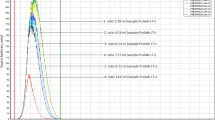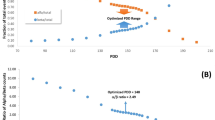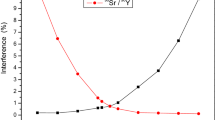Abstract
The liquid scintillation counting procedure for tritium quantification in environmental samples was optimized with respect to sample to cocktail volume ratio, fixing of region of interest of tritium spectra, and choice of counting vials for measurement of low-level activities of tritium in water samples. The optimum sample to cocktail ratio for Aqua-light scintillation cocktail based on the MDA values was found to be 8: 12 mL. The optimum window for tritium at optimum sample to cocktail ratio was found to be 2–12 keV based on figure of merit values, and the reduction in the background count rate was 31% compared to full window. The efficiency of the system at optimum sample to cocktail ratio was studied using two different quenching agents, carbon tetrachloride (CCl4) and nitromethane at different quench levels. It was found that quench effects were stronger for the standards with nitromethane compared to CCl4 at any specific volume. The tritium recovery factor for distillation technique, which is used for removing quenching agents present in water samples, was found to be 95% with the relative standard deviation of 0.34%. The conditions established in this paper are useful for measurement of low-level activities of tritium in the environmental samples.
Similar content being viewed by others
References
Knoll, G.F., Radiation Measurement and Detection, New York: Wiley, 2009, 3rd ed.
Be, M.-M, Chiste, V., and Dersch, R., Radioactive Half-Lives—Table of Recommended Values, Laboratoire National Henri Becquerel, 2008.
Management of waste containing tritium and carbon, Tech. Rep. Ser., Vienna: IAEA, 2004, no. 421.
Noakes, J. E. and De Filippis, S., in 2nd Int. Seminar for LSA, Tokyo: Packard, Tokyo, 1988, p. 123.
Pujol, Ll. and Sanchez-Cabeza, J.A., J. Radioanal. Nucl. Chem., 1999, vol. 242, no. 2, pp. 391–398.
Jakonić, I., Todorović, N., Nikolov, J., et al., Radiat. Phys. Chem., 2014, vol. 98, pp. 69–76.
Water quality: determination of tritium activity concentration, liquid scintillation counting method, ISO 9698, ISO, 2010, 2nd ed.
Varlam, C., Faurescu, I., Vagner, I., et al., J. Radioanal. Nucl. Chem., 2015, vol. 303, pp. 789–795.
Quantasmart for the Tricarb Liquid Scintillation Analyzer: Reference Manual 7000020, Rev. D, Perkin Elmer, 2003.
Edler, R., Available Quench Parameters in TriCarb LSC’s, LSC Application Note, Rodgau-Jügesheim: Perkin Elmer.
L’Annunziata, M.F. and Kessler, M.J., Handbook of Radioactivity Analysis, Amsterdam: Elsevier, 2012, 3rd ed.
Currie, L.A., Anal. Chem., 1968, vol. 40, no. 3, pp. 586–593.
Author information
Authors and Affiliations
Corresponding author
Rights and permissions
About this article
Cite this article
Arun, B., Vijayalakshmi, I., Sivasubramanian, K. et al. Optimization of Liquid Scintillation Counter for Tritium Estimation in Water Samples. Radiochemistry 61, 61–65 (2019). https://doi.org/10.1134/S1066362219010090
Received:
Revised:
Accepted:
Published:
Issue Date:
DOI: https://doi.org/10.1134/S1066362219010090




